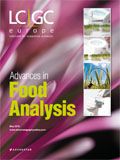Advances in Sample Preparation for Food Analysis
Special Issues
Sample preparation is a crucial part of the analysis of foodstuffs. Current sample preparation techniques used in food analysis are reviewed and the advantages and drawbacks of each one are discussed.
Foods are an extremely diverse group of products that are often supplemented with additional items such as preservatives, vitamins and antioxidants, and sometimes contaminated with harmful substances such as pesticides. Food analysis, promoted by industry, academia and government institutions, pushes research towards more advanced, sensitive and environmental-friendly methodologies. Sample preparation is a crucial part of the analysis of foodstuffs. Current sample preparation techniques used in food analysis are reviewed and the advantages and drawbacks of each one are discussed.
The concept of "food analysis" has grown in complexity as a result of international regulations and legislation, consumer demand and globalization of the food market. It is absolutely necessary to trace a detailed description of a food, in terms of its nutritional value, chemical composition, bioactivity and toxicological aspects.
The entire process, from the production, through to packaging and up to the introduction into the market, must be carefully monitored, and this is where food analysis plays a major role. In the last few years, a considerable variety of analytical methods applied to food analysis have been made available at the same rate as the increasing concern about food safety.
The choice of the analytical method depends upon various factors, such as nature of sample, goal of the analysis and the availability of resources (human and instrumental). Official analytical methods (i.e. AOAC International) are characterized by a high level of accuracy, precision and ruggedness, as a result of the validation of methods.
Food safety is an issue of topical interest, when considering the up-to-date consumer, attracted by healthy, dietetic and functional foods. This implies a deeper investigation that goes further than the mere determination of constituents, requiring a careful observation of the biological activities, if any, and their exploitation in the so-called "nutraceuticals". The latter designate a group of foods ("nutritional + pharmaceutical") with demonstrated health benefits, such as omega 3 fatty acids in milk. The final result of such a food screening leads to the creation of a comprehensive label, reporting a quali-quantitative description of the food product, along with nutritional indices and traceability.
Above all, it must be emphasized that a successful food analysis cannot be achieved without an appropriate, convenient and reliable sample preparation methodology.
The reliability of the conclusions drawn from a food analysis greatly depends upon the procedures used for sampling and sample preparation, which can be the most common source of errors. An ideal sample should be representative, in every part, of the bulk material from where it was taken. Grinding, chopping, digestion and centrifugation are some of the procedures utilized when performing sampling. Once the criterion of homogeneous sampling has been fulfilled, the sample must be made suitable for subsequent analysis.
Schematically, sample preparation can be performed in two basic steps: (i) extraction of target analytes; (ii) removal of interfering substances. Only occasionally can food samples be analysed directly: in most cases they need a sample clean-up step, necessary to remove interfering substances. Sometimes, this becomes a necessary step to make the analysis itself possible, as in the case of samples that need to be treated with derivatizing agents (e.g. methylation of free fatty acids prior to GC analysis). For example, if considering the headspace evaluation of a coffee aroma, there is no need to perform any sample preparation procedure, because the objective of the investigation is the evaluation of a property possessed by the sample in its original form.
However, the growing concern over food safety and its implications on human health has led to an increasing number of samples being tested and analyses being performed. Traditional techniques used for food sample preparation are often time-consuming and require consistent amounts of solvents and reagents. One of the objectives of analytical research in the last decade has been the miniaturization of the techniques used. Therefore, as will be described later, a series of "microextraction" techniques have been introduced, along with automated, fast, cheap and solventless sample preparation methods.
A schematic of the sample preparation techniques used in food analysis in the past decade is shown in Figure 1. However, this article will only outline the most innovative techniques, briefly discussing the advantages and drawbacks of each method.
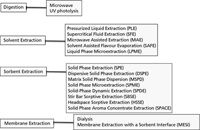
Figure 1
Solvent Extraction Pressurized Liquid Extraction (PLE): This technique, which is somehow related to Soxhlet extraction, exploits pressurized solvents that are brought to a temperature higher than their boiling point, without being vaporized because of the pressure applied. This procedure brings the solvent to a physical state that is close to that of a supercritical fluid, with a positive increase of its extraction efficiency. Usually, in a PLE process the temperature ranges between 80 °C and 200 °C, with a correspondent pressure range of about 1000–2500 psi. Originally, this technique was used in pollution control, PLE has been successively applied to a wide variety of food samples, such as vegetables, fruit juices, meat, baby food, fish, cereals and dairy products (1).
The technique has gained popularity because of the reduction of solvent consumption and improvement of extraction performance. In addition, PLE systems can be automated, are more environmentally-friendly (reduced waste production) and are safer to analysts as a result of the lower exposure to solvents. It cannot be underestimated that pressurization of liquids requires expensive equipment, provided with high pressure-proof vessels. Finally, a short remark concerns the case of moist samples, which need to be pre-treated with desiccants (alumina and silica) for water removal.
Microwave-assisted Extraction (MAE): Chemicals absorb microwaves in a manner that is directly proportional to their value of dielectric constant (ε): the higher the constant, the stronger the absorption. Based on this principle, microwaves can be used as an extraction aid in a procedure that can be theoretically placed between SFE (supercritical fluid extraction) and PLE. When performing a MAE, the analyst can choose to work with closed or open polytetrafluoroethylene (PTFE) vessels, depending upon the solvent used. When using a high ε solvent, the sample is put in a closed vessel, the solvent is heated by microwaves far above its boiling point and analytes are then extracted by the solvent. When using low ε solvents, samples are placed in an open vessel and microwaves will affect those sample components characterized by a higher ε, which will move to the surrounding cold solvent. There are many reports of successful extractions of a variety of food sample constituents, such as vitamins, pesticides, contaminants, sulphur compounds, terpenes and lipids, obtained by means of MAE (1–3). However, some drawbacks arise from the possible co-extraction of interfering compounds (i.e. pigments) causing a lack of selectivity.
Solvent-Assisted Flavour Evaporation (SAFE): Solvent-assisted flavour evaporation (SAFE) was introduced in 1999 by Engel et al. (4) with the aim of overcoming the drawbacks of the classical simultaneous distillation extraction (SDE), mainly represented by artifact formation and thermal degradation. SAFE apparatus consists of only one piece of glassware that avoids loss of analytes and their condensation. SAFE has been already applied to food matrices such as milk, fruit pulps and juices (2,5). Volatiles are stripped from the food matrix and collected into flasks, which are cooled with liquid nitrogen. The improvement of the extract quality can be perceived soon after the extraction is complete: no "cooked" smell or colour can be detected and in most cases no high boiling compounds can be found in the GC profile. One of the disadvantages of SAFE is the equipment maintainance, which is time-consuming, especially when dealing with fatty matrices.
Liquid-Phase Microextraction (LPME): The most recent sample preparation techniques have been modified into miniaturized versions which allows for both less consumption of solvents and analyte concentration. Therefore, liquid-liquid extraction has given birth to liquidphase microextraction (LPME), introduced by Jeannot and Cantwell in 1996 (6), also known as single drop microextraction (SDME). This technique exploits a drop, at the tip of a microsyringe, of a water-immiscible solvent immersed in an aqueous sample containing the analytes (7). Usually, a few microlitres of solvent are enough to allow the extraction. As soon as the extraction is considered complete, the drop is withdrawn into the needle and the injection into the instrument (for example, a GC system) can take place. Many acronyms are available to describe the different SDME operational modes: DI-SDME (direct immersionSDME), CFME (continuous flow-ME), DDME (dropto-drop-ME), DSDME (directly suspended droplet-ME), HS-SDME (headspace-SDME) and LLLME (liquid-liquid-liquid-ME). The simplicity of the technique and its low cost have made SDME an attractive alternative to classical liquid-liquid extraction. Also, the use of the microsyringe allows a readytoinject sample to be obtained in a short time. An acceptable choice of solvents (i.e., 1-octanol, ethylene glycol, xylene, hexane, etc.) contributes selectivity to SDME.
The technique can easily be automated, which improves repeatability data. Disadvantages of the technique consist of low sensitivity, depending upon sample complexity. Additionally, as reported by Bicchi et al. (8), sometimes the drop size can increase as a result of partial miscibility of the solvent with the aqueous sample, causing the drop to fall off the needle.
Other modifications of the original LPME are represented by dispersive liquid-liquid microextraction (DLLME) and hollow fibre-LPME (HF-LPME). In DLLME, an extra water-miscible solvent (defined as a disperser) is added to the water-immiscible solvent (the extractant) to increase the contact surface between the droplet and the aqueous sample. Generally, chlorobenzene, dichloromethane and tetrachloroethane are used as extracting solvents, whereas acetone, acetonitrile, methanol as disperser solvents.
HF-LPME has been introduced to overcome the droplet instability at the syringe tip. In this SDME-modified version, analytes are firstly extracted by a supported liquid membrane located into a porous hollow fibre, in the lumen of which the extracting solvent is placed.
Several applications on food analysis have been reported, such as the determination of pesticides in wine, tea, fruit juices, tomatoes and grapes, or the determination of inorganic analytes (i.e. lead) in milk, coffee and rice flour (9). One example is reported in Figure 2.
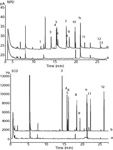
Figure 2
Sorbent Extraction
Solid-Phase Extraction (SPE): This extraction technique, actually better defined as "sample cleanup" technique, is one of the most widely used in food analysis and dates back to the 1980s. It is based on the use of disposable cartridges or discs packed with sorbent material, the most common being silica derivatized with alkyl octadecyl chains. The sample, dispersed in a liquid, is passed through the sorbent (pre-activated through solvation) bed, where analytes remain adsorbed, while undesired elements are not retained or selectively flushed away in a second step. Trapped target analytes are then extracted with a small amount of a solvent. The procedure is fast, simple, easily automated and environmentally friendly.
Recent advances in SPE can be attributed to the increasing availability of sorbent materials, which improves its selectivity. Generally, sorbents are grouped in polar, non-polar and ion-exchange, although today the new sorbent beds are designed in the same mould of HPLC column packing material. The most recent advance in SPE technology is represented by the molecularly imprinted polymers (MIPs), which are highly cross-linked and organized polymers aiming to mimic biological recognition (antibodies). They can be considered as "intelligent" polymers, that are capable of re-binding a target molecule (10). In fact, MIPs possess specific cavities designed for allocating template molecules under suitable conditions. Compared to traditional sorbents used in SPE cartridges, MIPs are characterized by higher storage stability, selectivity and sample capacity. Many different kinds of monomers are used for the preparation of MIPs: methacrylic acid, ethylene glycol dimethacrylate, 2-(diethylamino)ethyl methacrylate, etc., against templates such as atrazine, caffeine and chloramphenicol. Some drawbacks of MIPs are their synthesis methodology, that so far is not capable of producing highly specific binding sites. Furthermore, template bleeding interferes with quantification of trace compounds in complex samples. Figure 3 shows some HPLC chromatograms of fish and prawns extracted by MIPs.
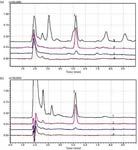
Figure 3
Dispersive Solid-Phase Extraction (DSPE): A novel SPE approach was introduced in 2003 by Anastassiades et al. (11). This method involves a preliminary food extraction by means of acetonitrile. In a second step, a salt (magnesium sulphate, sodium chloride and/or sodium sulphate) is added to drive partitioning between the aqueous and acetonitrile phases. The acetonitrile layer is then removed for further SPE clean-up. In dispersive SPE, the sorbent (generally PSA, primary-secondary amine), salt and solvent extract are mixed together, then centrifuged and the supernatant recovered, which contains the sample to be injected in the separation system (GC, LC or CZE). DSPE is strictly linked to a standardized AOAC extraction method for pesticides in food: QuEChERS, acronym of Quick, Easy, Cheap, Effective, Rugged, Safe. It was introduced by Lehotay in 2004, after several trials with buffers added to the SPE solvents and an interlaboratory study that involved 15 laboratories in 7 countries (12). The method has gained popularity worldwide because it is simple, fast, robust, validated and it covers a wide range of pesticides.
Matrix Solid-Phase Dispersion (MSPD): In 1989, in order to improve the effectiveness of SPE on biological matrices, Barker et al. (13) introduced MSPD that basically involves three steps: i) sample blending with a sorbent material (i.e., C18 silica); ii) packing of a pre-fritted SPE cartridge with the blend; iii) elution of analytes and/or interferences with suitable solvents. It must be emphasized that the use of solid-phase extraction cartridges or discs requires the sample to be liquid. Therefore, when dealing with solid samples, these need to be crushed, ground or homogenized before the extraction procedure. This is true also for viscous samples, or samples containing heavy particulate, that cannot be extracted unless they are previously diluted, filtrated, centrifuged and so on. All of these manipulations aim to destroy the architecture of the sample, which is an intrinsic feature, beyond leading to possible artefact/interference formation. These procedures are also tedious and often require a consistent amount of sample and solvents. MSPD can overcome such drawbacks, with simultaneous disruption/extraction of solid or viscous samples. Usually, the sample is crushed in a mortar where a sorbent is placed, therefore causing its dispersion over the surface of the sorbent. With subsequent solvent elution, it is possible to selectively get rid of undesired compounds, without eluting the analytes.
Generally, a mixture of solvents can be more effective to extract analytes. Common solvents used in MSPD are methanol, acetone and dichloromethane, sometimes added with triethylamine or acetic acid. However, the use of water-immiscible solvents leaves a residual amount of water that must be dried out, for example, by means of a nitrogen stream. One recent development of MSPD consists of the addition of cation exchange sorbent to the octadecyl silica blend. One of the first applications of MSPD was in the veterinary field, on organ tissues (13). Today, MSPD is strongly recommended for the extraction of lipids (for example, from meat). Also, the technique is a valid tool in the extraction of pesticides from foodstuff (14).
Solid-Phase Dynamic Extraction: (SPDE): This technique exploits a principle similar to that used in solid-phase microextraction (SPME), being based on the use of a thin film of sorbent, in this case coated on the inside wall of a hollow needle. First introduced as INCAT (Inside Needle Capillary Adsorption Trap) (15), this technique can extract and concentrate analytes directly onto the GC syringe, that is then injected into the GC system causing analytes to be thermally desorbed. The "magic needle", introduced by Lipinski in 2001 (16), differs from INCAT for the sorbent material used polydimethylsiloxane (PDMS) with 10% of activated carbon) and the syringe, which in this case is a gas-tight model. INCAT involves the use of a tube containing either a section of capillary column or simply carbon, where analytes are pulled in by means of a syringe or via diffusion. However, the INCAT technique did not become popular in food analysis, and was mostly applied to petrochemical analysis. However, SDME has been reported in a few food applications, including vegetables, wine and coffee (17), barley, malt and beer (18), honey (19) and organic crops (20). The advantage of SPDE over SPME is related to the possibility of pulling back and forth on the syringe plunger, allowing a number of consecutive SPDE cycles with enhancement of the concentration performance to be achieved. However, some disadvantages have prevented SPDE becoming popular, for example, method development and the need of dedicated instrumentation.
An apparatus similar to "magic needle", named micro extraction by packed sorbent (MEPS), has been introduced by Abdel-Rehim in 2004 and has been commercialized (21). It mainly consists of a micro-SPE apparatus, which uses a gas-tight syringe with a sorbent plug inside the barrel (see Figure 4). Derivatized silica or MIPs can be used to pack the syringe. Syringes can have a 100–250 µL size and sample volume ranges between 50 and 1000 µL. Sample drawing into the syringe occurs repetitively, allowing analytes to be absorbed. Two washing cycles, one with water for eluting undesired compounds, one with the GC or LC solvent for target analytes, take place before injecting the sample into the separation system. MEPS can be easily automated and hyphenated with devices such as largevolume injection (LVI) systems. The technique has been applied basically to the determination of analytes in wastewater, however, applications in food analysis (wine, beverages, milk, fish, oil, cereals and meat) are available from the company who holds the trademark (22).
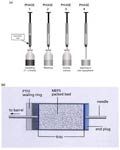
Figure 4
Headspace Sorptive Extraction (HSSE): Solid-phase microextraction (SPME) has become a popular new sample preparation technique. However, it should be remembered that more than twenty years have passed since its introduction, therefore the technique will not be described in this overview, which is dedicated to the most recent analytical approaches in food extraction. In spite of its wide popularity, SPME suffers from some drawbacks, one being the low concentration capability. It is for this reason that, firstly Baltussen et al. (23), with the stir bar sorptive extraction (SBSE) and secondly Bicchi et al. (24), with the headspace sorptive extraction (HSSE), modified the SPME assembly to enhance analyte recovery. SBSE exploits a glass-encapsulated stir bar coated with a layer of PDMS (25–250 µL). This device has been commercialized and it can easily be used to extract analytes from solutions. In HSSE, the same device is suspended in the sample headspace. Analytes accumulate on the coating and are then transferred into a thermal desorber connected to the GC system. A schematic of the technique is shown in Figure 5. Alternatively, analytes can be removed from the stir bar by means of liquidliquid extraction (LLE). One of the disadvantages of this technique is represented by the use of the sole PDMS as sorbent material, a fact that strongly limits its selectivity. Therefore, there are versions of this apparoach on the market that combine sorbents with different polarity, such polyethyleneglycol and silicone. HSSE has been applied to a wide variety of food matrices, such as vegetables, pesticides, olive oil and coffee (24–26).
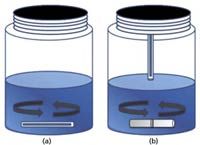
Figure 5
Solid-Phase Aroma Concentrate Extraction (SPACE): This sample extraction technique is a modified version of headspace SPME, basically exploiting a stainless steel rod coated with a mixture of sorbent material (mainly graphite carbon) (28). SAFE extraction consists of fixing the rod at the head of a closed Flask, where it adsorbs the aroma. As in SPME, the adsorbed analytes are released in the GC system by thermal desorption. The advantage of this technique is mainly related to the increased extraction surface, which allows enhanced sensitivity.
This approach has also recently been commercialized and is available in two different shapes and adsorbent materials: C18 silica, plain or with activated carbon, and designed as discs or rods. It is suggested that SPACE is used either by headspace or by immersion, followed by thermal desorption (with a dedicated device) or by solvent extraction supported by sonication. However, only one application of this technique can be found in the literature on the volatile composition of a plant species (28).
Conclusions
In this report, a brief overview of the recently introduced sample preparation techniques for food analysis has been described.
Food analysis is a complex issue that attracts researchers toward continuous modifications of current approaches and can involve:
(i) Micro-systems — to reduce chemical consumption and increase operator/environment safety;
(ii) Improving selectivity and sensitivity —to meet growing demands for trace analysis and targeted compound analysis (e.g. pesticides);
(iii) Automation — to improve repeatability while reducing the degree of errors.
It is worth reiterating that a successful food analysis depends very often on the sample preparation technique chosen. This choice cannot be done blindly, but in accordance with the chemical properties of analytes to be determined and the physical state of the sample matrix.
Finally, from an overview of the publications over the last ten years, it emerges that one of the big challenges to the analyst is the "quantitation" of extracted analytes, which is often complicated by the "non-exhaustive" character of some techniques, especially those falling into the "sorptive" group. In other words, this means that it is not useful to develop techniques that reduce costs and solvents consumption, if laborious procedures are needed for quantification. Technological enhancement should keep pace with quantitative analysis.
Rosaria Costa1 , Paola Dugo1,2 and Luigi Mondello1,2 1Dipartimento Farmaco-Chimico, Università di Messina, Messina, Italy, 2 Centro Integrato di Ricerca (C.I.R.), Università Campus BioMedico, Roma, Italy.
References
(1) P.L. Buldini, L. Ricci and J.L. Sharma, J. Chromatogr. A, 975(1), 47–70 (2002).
(2) E.N. Papadakis and A. Polychroniadou, Int. Dairy J., 15(2), 165–172 (2005).
(3) U. Hoeller, D. Wolter, P. Hofmann and V. Spitzer, J. Agric. Food Chem., 51(6), 1539–1542 (2003).
(4) W. Engel, W. Bahr and P. Schieberle, Eur. Food Res. Technol., 209(3–4), 237–241 (1999).
(5) M.S. Havemose, P. Justesen, W.L.P. Bredie and J.H. Nielsen, Int. Dairy J., 17(7), 746–752 (2007).
(6) M.A. Jeannot and F.F. Cantwell, Anal. Chem., 68(13), 2236–2240 (1996).
(7) M. Asensio-Ramos, L.M. RaveloPérez, M.À. González-Curbelo and J. Hernández-Borges, J. Chromatogr. A, 1218(42), 7415–7437 (2011).
(8) C. Bicchi, C. Cordero, E. Liberto, B. Sgorbini and P. Rubiolo, J. Chromatogr. A, 1184(1–2), 220–233 (2008).
(9) N.J.K. Simpson and M.J.M. Wells, in Solid-Phase Extraction – Principles, techniques and applications, N.J.K. Simpson ed., Marcel Dekker, New York (NY, USA), 1–18 (2000).
(10) C.M. Lok and R. Son, Int. Food Res. J., 16(2), 127–140 (2009).
(11) M. Anastassiades, S. Lehotay, D. Štajnbaher and F.J. Schenck, J. AOAC Int., 86(2), 412–431 (2003).
(12) S.J. Lehotay, Proceedings AOAC Annual Meeting, St. Louis, MO USA (2004).
(13) S.A. Barker, A.R. Long and C.R. Short, J. Chromatogr., 475(1–2), 353–361 (1989).
(14) S. Bogialli and A. Di Corcia, J. Biochem. Biophys. Methods, 70(2), 163–179 (2007).
(15) M.E. McComb, R.D. Oleschuk, E. Giller and H.D. Gesser, Talanta, 44(11), 2137–2143 (1997).
(16) J. Lipinski, Fres.J. Anal. Chem., 369(1), 57–62 (2001).
(17) C. Bicchi, C. Cordero, E. Liberto, P. Rubiolo and B. Sgorbini, J. Chromatogr. A, 1024(1–2), 217–226 (2004).
(18) Z. Svoboda, R. Mikulikova, S. Belakova, K. Benesova, I. Marova and Z. Nesvadba, Chromatographia, 73(Suppl. 1), 157–161 (2011).
(19) I. Christ, U.B. Kuehn and K. Strassburger, in Sensory-Directed Flavor Analysis, R. Marsili (Ed.), CRC Press, FL (USA), 155–180 (2006).
(20) S. Wimmer and M. Gartner, Ernaehrung, 29(9), 359–367 (2005).
(21) M. Abdel-Rehim, J. Chromatogr. B, 801(2), 317–321 (2004).
(22) N. Lahoutifard, P. Dawes and P. Wynne, SGE analytical science, Application no.TP-0189-M.
(23) E. Baltussen, P. Sandra, F. David and C. Cramers, J. Microcol. Sep., 11(10), 737–747 (1999).
(24) C. Bicchi, C. Cordero, C. Iori, P. Rubiolo and P. Sandra, J. High Resolut. Chromatogr., 23(9), 539–546 (2000).
(25) C. Bicchi, C. Iori, P. Rubiolo and P. Sandra, J. Agric. Food Chem., 50(3), 449–459 (2002).
(26) P. Grossi, I.R.B. Olivares, D.R. de Freitas and F.M. Lancas, J. Sep. Sci., 31(20), 3630–3637 (2008).
(27) M. Ishikawa, O. Ito, S. Ishizaki, Y. Kurobayashi and A. Fujita, Flavour Fragr. J., 19(3), 183–187 (2004)
(28) J. Hye-Jin, S. Hyun-Hwa and L. Dong-Sun, Bull. Korean Chem. Soc., 32(12), 4275–4280 (2011).
Analytical Challenges in Measuring Migration from Food Contact Materials
November 2nd 2015Food contact materials contain low molecular weight additives and processing aids which can migrate into foods leading to trace levels of contamination. Food safety is ensured through regulations, comprising compositional controls and migration limits, which present a significant analytical challenge to the food industry to ensure compliance and demonstrate due diligence. Of the various analytical approaches, LC-MS/MS has proved to be an essential tool in monitoring migration of target compounds into foods, and more sophisticated approaches such as LC-high resolution MS (Orbitrap) are being increasingly used for untargeted analysis to monitor non-intentionally added substances. This podcast will provide an overview to this area, illustrated with various applications showing current approaches being employed.
Multi-Step Preparative LC–MS Workflow for Peptide Purification
March 21st 2025This article introduces a multi-step preparative purification workflow for synthetic peptides using liquid chromatography–mass spectrometry (LC–MS). The process involves optimizing separation conditions, scaling-up, fractionating, and confirming purity and recovery, using a single LC–MS system. High purity and recovery rates for synthetic peptides such as parathormone (PTH) are achieved. The method allows efficient purification and accurate confirmation of peptide synthesis and is suitable for handling complex preparative purification tasks.

